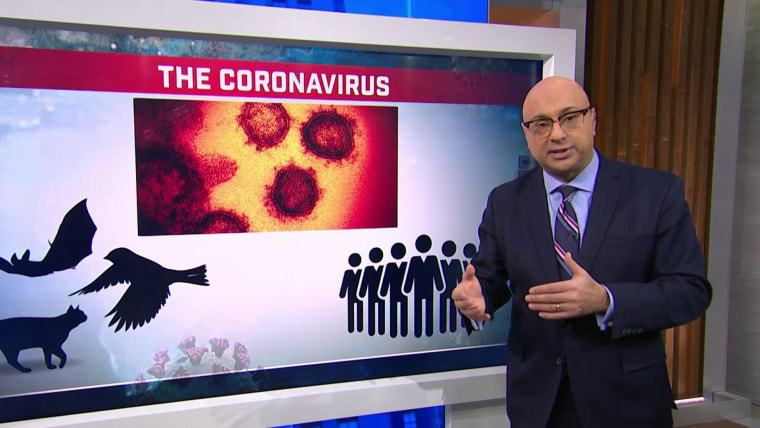As scientists and public health officials around the world scramble to contain the deadly coronavirus outbreak, some researchers are also racing to solve the enduring mystery of where the newly identified virus came from.
The coronavirus, which first sickened people in China in December, is thought to have passed from animals to humans, like many similar pathogens, but nothing has been confirmed yet by any peer-reviewed scientific research, global public health agency or academic expert. Beyond that, little is known about its origin.
Although finding the source wouldn't necessarily help scientists develop vaccines or other direct treatments, it could provide crucial pieces of information on how it emerged and evolved. And scientists are using lessons learned from previous outbreaks to know how to approach this one.
Early research suggests that the virus closely resembles a known coronavirus harbored in horseshoe bats, according to Ian Jones, a professor of virology at the University of Reading in England.
"What is not clear is the steps that moved the virus out of the bat, into some intermediate source or sources, and then finally into man," Jones said.
The virus' origin has been the focus of conspiracy theories and other forms of misinformation. In an interview with Fox News on Feb. 16, Sen. Tom Cotton, R-Ark., suggested that the coronavirus may have come from a virology laboratory in Wuhan, China, where the outbreak emerged. Others went further by raising the possibility that the virus was a leaked bioweapon.
Full coverage of the coronavirus outbreak
But scientists say the virus' similarities to known coronaviruses in animals — particularly bats — rule out the idea that it was created in a lab.
To trace a virus to its source, scientists typically look for clues in its molecular makeup. Chinese scientists published the coronavirus' sequenced genome less than two weeks after the first case in humans was reported — a lightning-fast development made possible by advancements in technology.
Let our news meet your inbox. The news and stories that matters, delivered weekday mornings.
"This would have taken us six months to a year to do before," said Gene Olinger, a Maryland-based virologist at MRIGlobal, a scientific research organization that is helping to develop diagnostic tools for the coronavirus. "We had those first sequences almost immediately — that's unheard of."
The virus' genome can't tell scientists everything about its source, but the string of DNA sequences functions almost like a blueprint for this type of detective work.
"The closest bat virus that we've seen is not able to infect human cells, so there had to be some intermediate animal," said Carolyn Machamer, a professor of cell biology at the Johns Hopkins University School of Medicine in Baltimore. "The bat virus can infect an intermediate animal, and during that replication, mutations arise that could promote infection in humans if they are in close contact."
Many coronaviruses are zoonotic diseases, which means they spread from animals to people. And there is precedent for coronavirus outbreaks that originate in bats and spill over into humans through an intermediate animal.
An outbreak of severe acute respiratory syndrome, or SARS, in 2003 is thought to have spread from bats to civet cats before the first human patient was infected. And Middle East respiratory syndrome, or MERS, another type of coronavirus that was first reported in Saudi Arabia in 2012, most likely passed from bats into dromedary camels before spilling over into humans.
Public health officials suspect that the current outbreak may have originated at a live-animal market in Wuhan, where dozens of workers were infected at the outset. The market has been shut down, but tests on samples from the area have been inconclusive.
In early February, a group of Chinese scientists suggested that genetic analyses pointed to pangolins — scaly, long-snouted anteaters — as a likely source of the outbreak. Their research showed that genetic sequences of coronaviruses isolated from pangolins are 99 percent similar to those of the current variant.
Jones said the pangolin theory is plausible, but he cautioned that the findings haven't yet been confirmed by independent scientific research.
Download the NBC News app for full coverage of the coronavirus outbreak
Researchers are also still unsure why this coronavirus was transmitted to humans. Mammals and birds are known reservoirs for coronaviruses, but the vast majority of them don't sicken people.
"There are plenty of coronaviruses that cause disease in animal species, but they're not thought to be a risk to humans," Jones said.
That mentality changed after the SARS outbreak, which spread to more than two dozen countries and killed 774 people.
"SARS was really the first human coronavirus to cause severe diseases," said Timothy Sheahan, an epidemiologist at the Gillings School of Global Public Health at the University of North Carolina. "Prior to that, coronavirus was only known to cause the common cold in people. Then MERS was discovered in 2012 and this virus emerges in 2019. So the fact that a new SARS-like virus has emerged to cause severe respiratory disease in people tells me this is likely going to happen again in the future."
Sheahan is working on possible antiviral drugs to fight the coronavirus, but he said the current outbreak demonstrates the importance of tracing the virus to its origin.
"Understanding the source of the virus will help us prevent spillovers in the future," he said. "From a public health perspective, it's important to flesh that out."
"come" - Google News
February 28, 2020 at 05:00PM
https://ift.tt/2I4LKCE
Where did the new coronavirus come from? Past outbreaks provide hints. - NBCNews.com
"come" - Google News
https://ift.tt/2S8UtrZ
Shoes Man Tutorial
Pos News Update
Meme Update
Korean Entertainment News
Japan News Update
Bagikan Berita Ini















0 Response to "Where did the new coronavirus come from? Past outbreaks provide hints. - NBCNews.com"
Post a Comment